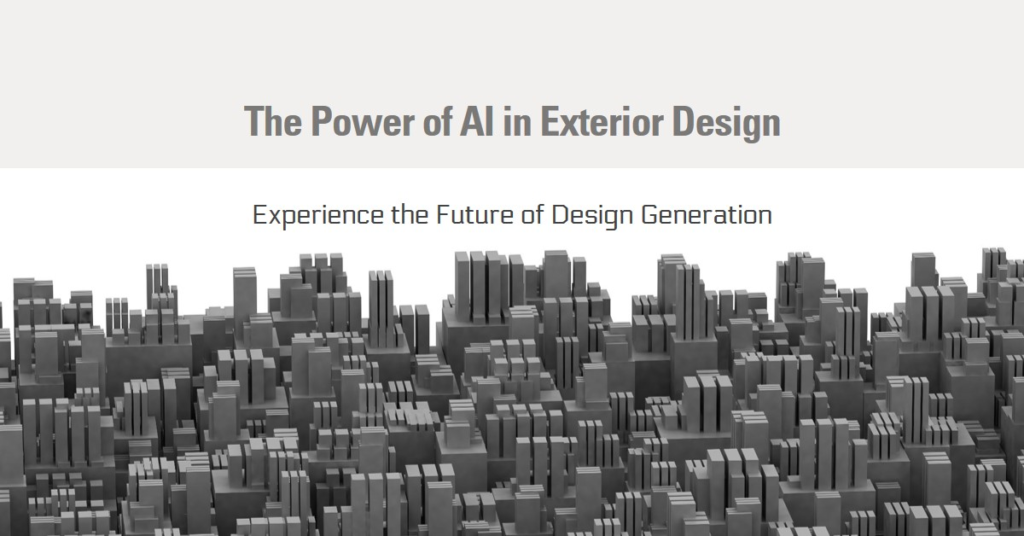
Table of Contents
- Introduction to AI in Exterior Design:
- The Evolution of Exterior Design: From Hand Sketches to AI
- Harnessing AI for Design Generation:
- Enhancing Creativity with AI:
- Streamlining the Design Process:
- Sustainable Design Solutions:
- Predictive Analysis and Future Trends:
- Real-World Applications and Case Studies:
- Overcoming Challenges and Ethical Considerations:
- The Future of AI in Exterior Design:
- Conclusion: Embracing the AI-Driven Future
Introduction to AI in Exterior Design:
Artificial Intelligence (AI) has permeated various industries, bringing transformative changes and unprecedented efficiencies. One such industry experiencing a significant impact is exterior design. Traditionally a domain reliant on human creativity and manual effort, exterior design is now being revolutionized by AI technologies. From conceptualization to final visualization, AI is enabling designers to explore innovative ideas, optimize designs, and streamline workflows like never before.
In this blog post, we will delve into the myriad ways AI is reshaping exterior design. We will explore its applications, benefits, and the future potential of AI-driven exterior design generation. As we navigate through various sections, the power of AI in enhancing creativity, efficiency, and sustainability will become evident.
The Evolution of Exterior Design: From Hand Sketches to AI
Exterior design has evolved dramatically over the years. Initially, designers relied heavily on hand sketches and physical models. This traditional approach, though artistic, was time-consuming and limited by human capability. The advent of computer-aided design (CAD) marked a significant milestone, introducing digital tools that enhanced precision and allowed for more complex designs.
Today, AI is pushing the boundaries even further. By leveraging machine learning algorithms and vast datasets, AI can analyze, predict, and generate design solutions with remarkable speed and accuracy. This evolution from hand sketches to AI-driven tools represents a paradigm shift, making exterior design more dynamic and responsive to contemporary needs.
Harnessing AI for Design Generation:
AI in exterior design generation operates on several fronts. One of the most prominent applications is generative design, where AI algorithms create multiple design variations based on specific input parameters. These algorithms consider factors such as site conditions, climate, materials, and aesthetics, producing a range of optimized designs.
Designers can then evaluate these AI-generated options, selecting the ones that best meet their criteria. This process not only accelerates the design phase but also introduces innovative solutions that might not have been conceived manually. By harnessing AI, designers can explore a broader spectrum of possibilities, enhancing both creativity and functionality.
Enhancing Creativity with AI:
Contrary to the belief that AI stifles creativity, it actually serves as a powerful enabler. AI tools can provide designers with new perspectives and inspiration by analyzing existing designs and trends. For instance, AI can identify and amalgamate elements from various architectural styles, suggesting unique combinations that might not be immediately apparent to human designers.
Moreover, AI-driven platforms can simulate different materials and color schemes, allowing designers to experiment freely without the constraints of traditional methods. This enhanced creative process leads to more innovative and aesthetically pleasing designs, enriching the overall design landscape.
Streamlining the Design Process:
Efficiency is a key advantage of incorporating AI into exterior design. AI algorithms can automate routine tasks such as drafting, rendering, and documentation. By handling these time-consuming activities, AI allows designers to focus on more strategic and creative aspects of the project.
Additionally, AI-powered tools can facilitate collaboration among design teams. Cloud-based platforms enable real-time sharing and modification of design files, ensuring that all stakeholders are aligned and can contribute effectively. This streamlined process reduces the likelihood of errors and accelerates project timelines, ultimately leading to cost savings and higher client satisfaction.
Sustainable Design Solutions:
Sustainability is a growing concern in the architectural and design industries. AI plays a crucial role in promoting environmentally friendly design practices. By analyzing environmental data and predicting the impact of various design choices, AI helps designers create sustainable solutions that minimize negative effects on the environment.
For example, AI can optimize building orientation, material selection, and energy usage to enhance sustainability. It can also simulate the long-term performance of designs under different climatic conditions, ensuring that the final product is not only aesthetically pleasing but also environmentally responsible. This capability aligns with the increasing demand for green architecture and sustainable urban planning.
Predictive Analysis and Future Trends:
AI’s predictive capabilities extend beyond design generation. By analyzing historical data and current trends, AI can forecast future design trends and consumer preferences. This insight allows designers to stay ahead of the curve, creating designs that are both innovative and market-ready.
Predictive analysis also aids in risk management. AI can identify potential issues in the design phase, such as structural weaknesses or compliance with local regulations, before they become costly problems. This proactive approach ensures that designs are not only cutting-edge but also feasible and safe.


Real-World Applications and Case Studies:
The real-world applications of AI in exterior design are vast and varied. From residential projects to large-scale urban developments, AI is being utilized to create efficient, innovative, and sustainable designs. Case studies of successful projects highlight the tangible benefits of integrating AI into the design process.
For instance, a notable project might involve the use of AI to design a new urban park. By analyzing pedestrian traffic patterns, environmental conditions, and community needs, AI can propose designs that maximize utility, aesthetics, and sustainability. Such examples demonstrate the practical advantages of AI in addressing complex design challenges.
Overcoming Challenges and Ethical Considerations:
Despite its numerous benefits, the integration of AI in exterior design is not without challenges. Issues such as data privacy, algorithmic bias, and the need for substantial computational resources must be addressed. Moreover, the ethical implications of AI-driven design decisions warrant careful consideration.
To overcome these challenges, it is essential to establish robust frameworks for data security and ethical AI usage. Collaboration between designers, technologists, and policymakers is crucial in ensuring that AI is used responsibly and transparently. By addressing these concerns, the industry can harness the full potential of AI while maintaining ethical standards.
The Future of AI in Exterior Design:
Looking ahead, the role of AI in exterior design is set to expand even further. Advances in AI technology, such as deep learning and neural networks, will enhance the ability to generate and optimize designs. The integration of AI with other emerging technologies, such as augmented reality (AR) and virtual reality (VR), will create immersive design experiences and facilitate better client engagement.
Furthermore, AI’s potential to support mass customization and personalized design solutions will redefine the industry. As AI becomes more sophisticated, it will empower designers to create bespoke designs that cater to individual preferences and specific site conditions, ushering in a new era of personalized architecture.
Conclusion: Embracing the AI-Driven Future
The power of AI in exterior design generation is undeniable. From enhancing creativity and efficiency to promoting sustainability and predicting future trends, AI is transforming the way designers approach their craft. As the technology continues to evolve, the possibilities for innovation and improvement are boundless.
By embracing AI, designers can push the boundaries of what is possible, creating exterior designs that are not only beautiful and functional but also sustainable and forward-thinking. The future of exterior design lies in the harmonious blend of human creativity and AI capabilities, promising a dynamic and exciting evolution for the industry.


